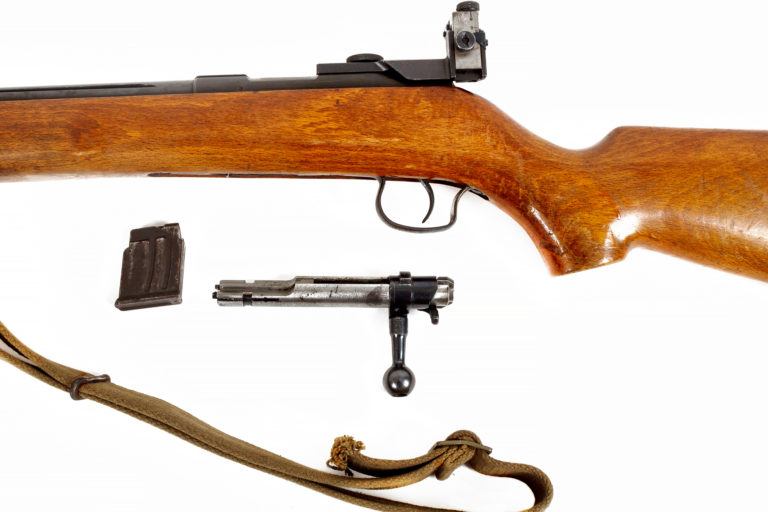
Quick Tips
A bolt-action rifle is a masterpiece of precision, but neglecting to clean it can turn that precision into frustration. Carbon buildup, moisture, and debris can affect accuracy, damage internal components, and shorten the lifespan of your firearm. Regular maintenance ensures smooth operation, better performance, and safety every time you pull the trigger. If you’re cleaning other firearms, you may also want to check out our guide on How to Clean a 22 Rifle for additional firearm maintenance tips. Follow these seven steps to clean your bolt-action rifle properly and keep it in peak condition.
Essential Supplies You’ll Need
- Cleaning rod with bore brushes and patches
- Bore cleaner or solvent
- Gun oil or lubricant
- Cleaning jag and patch holder
- Nylon or brass brush
- Microfiber cloths or lint-free rags
- Cotton swabs or pipe cleaners
- Gunsmithing screwdriver set (if disassembly is required)
- Protective gloves (optional but recommended)
Step-by-Step: How to Clean a Bolt-Action Rifle
1. Unload and Disassemble
Before doing anything, double-check that the rifle is unloaded. Remove the magazine and visually inspect the chamber to ensure there is no round inside. If your rifle allows it, remove the bolt by pulling it back and engaging the bolt release mechanism. Consult your firearm’s manual if you’re unsure how to do this properly. A safe and stable work surface with good lighting makes the cleaning process easier and prevents small parts from getting lost.
2. Clean the Bore with a Solvent
Attach a cleaning patch soaked in bore cleaner to a jag and push it through the barrel from the chamber end to the muzzle. Never pull a dirty patch back through the bore, as this can redeposit fouling. Repeat this step with new patches until they come out clean. For heavy carbon buildup, let the solvent sit for a few minutes before running a bore brush through the barrel several times. Follow up with dry patches to remove excess cleaner.
3. Scrub the Chamber and Bolt
Using a nylon or brass brush, clean the chamber to remove any buildup. Carbon and residue tend to accumulate in this area, affecting feeding and extraction. For the bolt, wipe it down with a solvent-soaked cloth, paying close attention to the bolt face and locking lugs. If the bolt is particularly dirty, use cotton swabs or a small brush to get into the crevices. Dry the bolt thoroughly before moving on to lubrication.
4. Wipe Down the Exterior
A microfiber cloth lightly dampened with solvent can be used to remove fingerprints, dirt, and moisture from the barrel and action. If your rifle has a wooden stock, avoid getting solvent on the wood, as it can degrade the finish over time. For synthetic stocks, a simple wipe-down with a damp cloth is usually sufficient. Check for any signs of rust or wear that may need attention. If rust is an issue, our article on How to Clean Aluminum provides insights on dealing with metal oxidation.
5. Apply Lubrication Sparingly
Excess oil attracts dirt and can cause more problems than it prevents, so apply lubrication sparingly. A small amount of gun oil should be applied to the bolt’s contact points, the locking lugs, and any areas where metal rubs against metal. Lightly oil a cleaning patch and pass it through the bore to protect it from moisture and corrosion. Wipe away any excess oil with a dry cloth.
6. Reassemble and Function Test
Once all parts are clean and dry, reassemble the rifle by reinserting the bolt and ensuring smooth operation. Work the action a few times to distribute the lubricant and check for any unusual resistance. If something feels off, double-check that all components are properly seated and tightened.
7. Store the Rifle Properly
Proper storage is just as important as cleaning. Store the rifle in a cool, dry place with low humidity. Using a gun safe with a dehumidifier helps prevent rust and moisture damage. If storing the rifle for an extended period, consider using a silicone-treated gun sock or lightly oiling the exterior to provide extra protection.
How Professionals Clean Bolt-Action Rifles
Experienced gunsmiths and competitive shooters follow strict cleaning protocols to keep their rifles in top condition. According to experts from sources like the National Shooting Sports Foundation (NSSF) and firearm manufacturers, professionals use the following techniques: The NSSF provides in-depth firearm maintenance recommendations, which you can explore further at NSSF.org.
- Bore guides to ensure the cleaning rod travels straight and prevents damage to the rifling.
- Ultrasonic cleaners for deep cleaning small components like bolts and triggers.
- Specialized carbon-removing solvents for extreme fouling, especially in high-round-count rifles.
- Bore-scoping tools to inspect rifling wear and detect hidden carbon deposits.
- Torque wrenches to properly reassemble rifles to factory specifications.
For shooters who rely on their rifles for hunting or competition, adopting some of these advanced techniques can help maintain accuracy and reliability over time.
Pro Tips for Keeping Your Rifle Cleaner, Longer
- Clean your rifle after every range session to prevent carbon buildup.
- Always store it in a low-humidity environment to avoid rust.
- Use a chamber flag or bore plug during cleaning to avoid solvent drips where they don’t belong.
- Rotate patches when cleaning to avoid redepositing fouling.
- Keep a log of maintenance to track how often you clean and lubricate your rifle.
Final Thoughts
A well-maintained bolt-action rifle lasts longer, shoots more accurately, and operates more reliably. Regular cleaning doesn’t just preserve the firearm’s lifespan—it also ensures safety and peak performance. Whether you’re a hunter, a competitive shooter, or a casual range-goer, following these seven steps will keep your rifle in top shape for years to come.